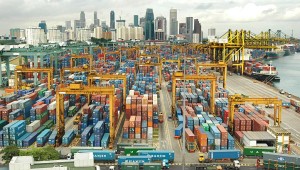
In the clearest sign yet that the lingering effects of the 2009 global financial crisis on the shipping industry have come to an end, global container port throughput figures surged in the third quarter of this year.
According to Alphaliner’s quarterly port survey – which covers the 200 ports representing around 75% of global container handling – global throughput grew 7.7% year-on-year.
This was the highest rate of growth since the beginning of 2011, which, in turn, had marked the end of a worldwide inventory restocking phase in the aftermath of the crash.
The third quarter saw a continuation of the 7.4% and 5.8% gains seen in the first and second quarters, respectively, and growth was seen in every region, even Latin America and its previously moribund economic engine, Brazil.
South and Central American volumes grew 10% overall, led by double-digit growth across Mexico, while the key Brazilian gateway of Santos grew 6.6%. Growth was also seen at Rio Grande, Paranagua and Itajai.
The developed western markets of North America and Europe also saw a strong recovery in volumes, buoyed by the continued strength of the US economy. North American ports saw a combined growth of 8.7%; North Europe by 4.7% and the Mediterranean and other South Europe regions by 8.2%.
Growth at China’s ports, including Hong Kong, hit 9.3%, outpacing other ports in both North and South-east Asia, which grew 4.3% and 4.2% respectively.
The strongest ports were container gateways, rather than transhipment hubs. The chief import receiving gateways of Los Angeles, New York and Rotterdam all saw double-digit increases, although growth was more muted at Antwerp and Hamburg, which saw increases of 5.8% and 1.2% respectively.
And double-digit growth was also seen at a host of Chinese export gateways.
The picture for transhipment hubs was far more mixed, however, as the effect of the new alliance structures made themselves felt. Singapore was up 9.9%; the 2M’s Malaysian transhipment hub of Tanjung Pelepas 13% and even Hong Kong reversed a long-term decline to post 4.9% growth in volumes.
In contrast, Malaysia’s Port Klang was down 15.1%, and Algeciras continued to feel the effects of nearby competition from Tangiers and Spanish competitors such as Las Palmas and Valencia to post a drop of 19.4% in volumes.
As has become increasingly obvious, however, strong demand failed to propel freight rates as the industry-wide introduction of new capacity outpaced even the strong underlying volumes.
“Despite the high-volume growth rate recorded in the third quarter, carriers have largely failed to capitalise on the improved demand conditions,” said Alphaliner.
“Total effective capacity growth has outpaced the growth in demand, reaching 8.1% at the end of September this year, due to the combined effects of new ship deliveries and a reduction in the idle fleet.”
It expected the increase in the global fleet to continue through to the end of the year, with the capacity increase reaching 9% by the end of last month.